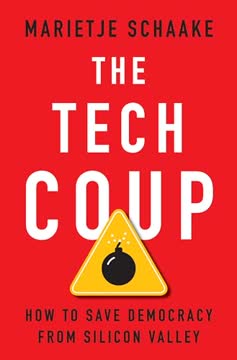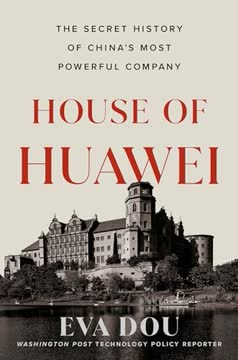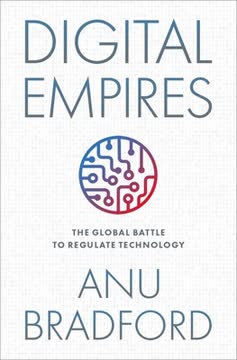Key Takeaways
1. Three Digital Empires Offer Competing Regulatory Models
Today, there are three dominant digital powers—the US, China, and the EU—who can metaphorically be thought of as “digital empires.”
Distinct visions. The global digital economy is shaped by three major powers, each with a unique approach to regulating technology. These "digital empires" – the US, China, and the EU – have developed distinct domestic governance models reflecting their core ideological commitments.
- US: Market-driven, prioritizing innovation and free speech.
- China: State-driven, emphasizing control and technological dominance.
- EU: Rights-driven, focusing on individual and collective rights.
Exporting models. Like historical empires, these digital powers export their models, technologies, and rules, influencing other countries and individuals. This expansion creates spheres of influence, pulling other nations into their respective orbits.
Contested choices. Each model involves societal choices based on differing economic theories, political ideologies, and cultural identities. Balancing innovation with civil liberties, wealth distribution, and national security leads to notable differences, and no global consensus exists on which model is best.
2. The American Model Champions Market-Driven Freedom
The American regulatory approach centers on protecting free speech, the free internet, and incentives to innovate.
Techno-optimism prevails. The US model is rooted in a belief that the internet fosters economic prosperity and political freedom, viewing government intervention as detrimental to both markets and individual liberty. This techno-libertarian view minimizes the state's role, except for national security concerns like cybersecurity.
Legal foundations. This market-driven ethos is embedded in US law, notably Section 230 of the Communications Decency Act, which shields platforms from liability for user content, encouraging self-regulation. Weak antitrust enforcement and the absence of a federal privacy law further reflect this limited government approach.
Criticism mounts. Despite fostering innovation and tech giants, the model is criticized for neglecting individual rights. Critics point to:
- Surveillance capitalism and data privacy violations (e.g., Cambridge Analytica).
- Rampant disinformation and harmful content undermining democracy (e.g., January 6th).
- Excessive concentration of power in a few large companies.
3. The Chinese Model Prioritizes State-Driven Control
The Chinese government seeks to maximize the country’s technological dominance while maintaining social harmony and control over its citizens’ communications.
Dual objectives. China's state-driven model uses technology for two primary goals: fueling economic growth to maintain the Communist Party's legitimacy and tightening political control through surveillance and censorship to ensure social stability.
Authoritarian tools. The government employs extensive measures to control the digital space:
- The Great Firewall blocks foreign content and platforms.
- Laws mandate censorship and remove user anonymity.
- Sophisticated AI, including facial recognition, powers mass surveillance programs like Sharp Eyes.
- The social credit system rates citizens' trustworthiness.
Tech companies as tools. Chinese tech giants like Alibaba and Tencent initially benefited from lax regulation but are increasingly harnessed as state surrogates for surveillance and control. Recent crackdowns aim to cement state control over these powerful firms.
4. The European Model Centers on Rights-Driven Governance
The EU embraces a human-centric approach to regulating the digital economy where fundamental rights and the notion of a fair marketplace form the foundation for regulation.
Balancing rights. Unlike the US focus on free speech or China's state control, the EU balances free speech with other fundamental rights like human dignity, privacy, and non-discrimination. Regulation is seen as necessary to protect citizens from both tech companies and the state.
Rule of law. The EU model insists that digital transformation must be anchored in the rule of law and democratic governance. Key regulations include:
- GDPR: Comprehensive data protection law granting individuals control over personal data.
- AI Act (proposed): Risk-based regulation promoting ethical, trustworthy, and human-centric AI.
- DSA: Binding rules on content moderation, transparency, and accountability for online platforms.
Fairness and redistribution. The EU also uses regulation to promote a fairer digital economy, addressing power imbalances through:
- Antitrust law: Challenging dominant companies' practices (e.g., Google Shopping).
- Digital taxation: Seeking to tax revenue generated in market jurisdictions.
- Platform work regulation: Improving working conditions and social protections for gig workers.
5. Imperial Rivalries Spark Horizontal and Vertical Battles
Due to the global nature of the digital economy, these leading regulatory models extend across jurisdictions, impacting foreign societies and shaping lives of foreign individuals.
Colliding models. The distinct US, China, and EU models frequently clash internationally, leading to fierce battles. These rivalries occur on two levels:
- Horizontal: Conflicts between governments (US vs. China, US vs. EU).
- Vertical: Conflicts between governments and tech companies operating in their markets.
Tech companies caught in the middle. Global tech companies often face conflicting demands from different governments, making compliance difficult or impossible. For example:
- Microsoft was caught between US law enforcement demanding data and EU regulators prohibiting transfer.
- Apple navigates Chinese censorship demands while facing criticism in the US for compromising values.
- TikTok faces US national security concerns while its Chinese parent company is subject to Chinese data laws.
Interconnected battles. Horizontal and vertical battles are deeply intertwined. Governments are often reluctant to regulate their own tech companies too aggressively for fear of weakening them in horizontal rivalries, leading to strategic restraint.
6. The US-China Tech War Accelerates Decoupling
This superpower conflict, many would argue, is also the main theatre of war where the highest-stakes battles for the future of the global digital economy are being fought.
Escalating conflict. The US and China are locked in an intensifying tech war, viewing technological supremacy as key to economic and geopolitical power. This rivalry is accelerating the decoupling of their tech ecosystems.
US offensive. The US employs measures to counter China's rise:
- Export controls: Restricting China's access to critical technologies (e.g., semiconductors).
- Investment screening: Limiting Chinese investment in sensitive US tech assets (e.g., 5G networks).
- Human decoupling: Restricting visas for Chinese students and researchers.
- Sanctions: Targeting Chinese firms involved in cyberattacks or human rights abuses.
China's response. China counters US measures and pursues self-sufficiency:
- Export controls: Implementing its own laws (e.g., Export Control Law, Unreliable Entities List).
- Data restrictions: Limiting data outflow and requiring cybersecurity reviews for foreign IPOs.
- Investment screening: Formalizing review of foreign investment on national security grounds.
- Subsidies: Pouring state funding into strategic industries (e.g., semiconductors, AI).
Costly rivalry. The tech war is costly for both sides and fuels global techno-nationalism. While complete decoupling is unlikely due to deep interdependencies, the conflict will likely remain protracted and costly, featuring alternating periods of escalation and restraint.
7. The US-EU Regulatory Clash Reveals Value Differences
Thus, at the heart of these transatlantic battles lies a difference in philosophy about the relative roles of markets and the government in shaping the digital economy and digital society.
Clashing philosophies. The US and EU, despite shared democratic values, disagree on how to govern the digital economy. The EU distrusts tech companies' power, while the US distrusts government intervention.
Key battlegrounds:
- Data privacy: EU's fundamental right approach clashes with US national security/market approach, disrupting data flows (e.g., Schrems I & II invalidating Safe Harbor/Privacy Shield).
- Digital taxation: European efforts to tax revenue generated in market jurisdictions are seen by the US as discriminatory protectionism.
- Antitrust: EU's aggressive enforcement against US tech giants is viewed by the US as unfair targeting of successful rivals.
Moving towards convergence. Despite past friction, transatlantic alignment is increasing. The US is becoming more critical of its market-driven model and acknowledging the need for regulation, moving closer to the EU's stance.
Shared threat. The rise of China's digital authoritarianism provides a strong impetus for US-EU cooperation. Both recognize that their differences are manageable compared to China's model and that a united front is needed to defend liberal democracy in the digital age.
8. Digital Empires Expand Influence Globally
In addition to engaging in rivalries with each other, the three digital empires are also competing for global influence by exporting their regulatory models to other countries.
Competing for influence. The US, China, and EU seek to expand their spheres of influence, pulling other countries towards their respective norms and values. This competition shapes the digital destinies of societies worldwide.
Different methods of export:
- US: Private power, leveraging the global dominance of its tech companies.
- China: Infrastructure power, building digital networks and supplying technology.
- EU: Regulatory power, externalizing its rules through the Brussels Effect.
Externalities. This expansion generates both positive (e.g., access to valuable services, enhanced privacy) and negative (e.g., surveillance, harmful content, regulatory constraints) externalities in foreign jurisdictions.
"Empires by invitation". While criticized for potential dominance, these empires are often welcomed by foreign stakeholders seeking digital development, consumer products, or regulatory protections.
9. America's Influence Wanes Amidst Backlash
Consequently, when looking strictly at innovation and economic growth, the American market-driven model can be praised for its ability to nurture tech companies, but that economic benefit comes at the expense of risking fundamental rights, human dignity, political autonomy, and democracy.
Private power abroad. The US model's global influence stemmed from its tech companies' expansion, shaping foreign digital economies through their business practices and embedding American values. The US government actively promoted this through its "internet freedom agenda."
Backlash grows. The unmitigated power and harmful practices of US tech companies abroad have triggered a significant backlash:
- Facilitating genocide (Myanmar) and election interference (Brexit).
- Hosting hate speech and disinformation leading to real-world violence.
- Enabling government propaganda and surveillance.
- Inadequate content moderation in foreign languages.
Internet freedom's failure. The US government's internet freedom agenda, promoting non-regulation and anti-censorship, has largely failed to foster democracy abroad and lost credibility due to US surveillance practices (Snowden revelations) and domestic issues (January 6th).
Decline of the model. This growing resentment and the model's perceived failures are eroding the global influence of the American market-driven regulatory model, creating space for the EU and China to gain traction as alternatives.
10. China Exports Digital Authoritarianism via Infrastructure
Moreover, as a growing number of countries are choosing Chinese technology, Chinese technical standards associated with those technologies are also becoming more common—ultimately reaching the point of becoming default standards around which other technologies must be built.
Infrastructure as influence. China expands its global influence by supplying digital infrastructures (5G, cables, data centers) and foundational technologies (AI, surveillance) through the Digital Silk Road, establishing "infrastructure power."
Path dependency. By building the digital backbone, Chinese companies lock recipient countries into using Chinese technologies and standards, tying them closer to China's tech ecosystem and potentially exposing them to Chinese government influence.
Standard setting. China actively seeks influence in international standard-setting bodies, promoting its national standards (e.g., New IP proposal) to gain economic advantage and strategic leverage.
Digital authoritarian export. The DSR facilitates the spread of China's state-driven model by providing tools for surveillance and control (e.g., smart/safe cities), appealing to authoritarian governments seeking to cement power.
11. Europe Globalizes Rights Through Regulatory Power
In this way, market forces and companies’ business incentives alone are often sufficient to convert the EU’s data privacy regulation into a global regulation.
The Brussels Effect. The EU's global influence stems from its regulatory power, leveraging its large market and stringent rules to shape global markets. Companies comply with EU rules to access the market, often adopting them globally (de facto Brussels Effect).
Regulatory export. EU regulations also serve as templates for foreign governments, leading to the adoption of EU-style laws (de jure Brussels Effect). This is most evident in data privacy (GDPR inspiring laws worldwide).
Beyond privacy. The Brussels Effect extends to other areas:
- Content moderation: EU codes and the DSA influence global platform policies and inspire foreign legislation (e.g., Australia, UK).
- Antitrust: EU enforcement inspires foreign probes, and the DMA serves as a model for new regulations (e.g., UK, Japan, South Korea).
- AI: EU's proposed AI Act is influencing global AI ethics frameworks and potential regulations.
Regulatory superpower. The EU's ability to externalize its rights-driven model makes it a major player in shaping the global digital economy, often using foreign companies to spread its norms.
12. The Ultimate Battle: Liberal Democracy's Fate
In the end, it is this existential battle over the fate of liberal democracy as a form of government that will provide the US and the EU with the greatest impetus to join forces in both their horizontal and vertical battles—knowing that, if that fight is lost, the battle for the soul of the digital economy is also lost.
A bipolar future. A unipolar or multipolar digital world is unlikely. The most probable outcome is a bipolar order where a US-EU-led coalition of techno-democracies confronts techno-autocracies led by China, with battle lines drawn along ideological divides.
Threats to democracy. Liberal democracy faces threats from two directions:
- Losing the horizontal battle to China, leading to the spread of digital authoritarianism.
- Losing the vertical battle to tech companies, leaving societies at the mercy of corporate power.
Convergence and cooperation. The US is increasingly aligning with the EU's regulatory approach due to domestic shifts and the shared threat from China. This convergence strengthens the potential for a united front among techno-democracies.
The soul of the digital economy. The stakes are the future of liberal democracy itself. The battle will determine whether technology empowers individuals and serves democratic values or becomes a tool for state control and corporate exploitation.
Last updated:
FAQ
1. What is Digital Empires: The Global Battle to Regulate Technology by Anu Bradford about?
- Comparative analysis of digital regulation: The book examines how the US, EU, and China have developed distinct regulatory models for the digital economy, each reflecting different political, economic, and cultural values.
- Global power struggle: It explores how these "digital empires" use regulation as a tool of geopolitical influence, shaping global technology governance and competing for digital supremacy.
- Impact on companies and societies: Bradford details how these regulatory models affect tech companies, innovation, privacy, and the broader societal and political order worldwide.
2. Why should I read Digital Empires by Anu Bradford?
- Essential for understanding tech geopolitics: The book provides critical insights into the ongoing global battle for technological dominance and regulatory control, which is shaping the future of the digital world.
- Clarifies complex regulatory frameworks: Bradford breaks down intricate legal and policy issues, making them accessible for readers interested in technology, law, or international relations.
- Timely and forward-looking: The analysis covers current events like the US–China tech war, the rise of digital authoritarianism, and emerging issues such as AI regulation, equipping readers to anticipate future trends.
3. What are the key takeaways from Digital Empires by Anu Bradford?
- Three competing models: The American market-driven, European rights-driven, and Chinese state-driven models are shaping the global digital order, each with unique strengths and weaknesses.
- Fragmentation and rivalry: The world is moving toward a fragmented digital landscape, with increasing regulatory divergence and the risk of a "splinternet."
- Democracy at stake: The outcome of these regulatory battles will influence the future of liberal democracy, individual rights, and global economic power.
- Need for alliances: Bradford argues for coalitions among democracies to defend shared digital values and counter authoritarian models.
4. What are the three dominant regulatory models discussed in Digital Empires by Anu Bradford?
- American market-driven model: Prioritizes free markets, innovation, and minimal government intervention, relying on private sector self-regulation and strong protections for free speech.
- European rights-driven model: Emphasizes fundamental rights, privacy, and social fairness, with robust government regulation exemplified by laws like the GDPR and the Digital Services Act.
- Chinese state-driven model: Centers on strong government control, censorship, and digital authoritarianism, integrating technology regulation with national security and social stability goals.
5. How does the American market-driven regulatory model work according to Anu Bradford?
- Techno-libertarian roots: The US model is rooted in the "Californian ideology," blending free-market capitalism with countercultural ideals and a deep skepticism of government regulation.
- Legal foundations: Laws like Section 230 of the Communications Decency Act shield platforms from liability for user content, encouraging innovation and free speech.
- Current challenges: Growing concerns about monopolistic practices, privacy violations, and harmful content are fueling calls for more regulation, but political and judicial support for market freedom remains strong.
6. What characterizes the European rights-driven regulatory model in Digital Empires by Anu Bradford?
- Human-centric and rights-based: The EU model prioritizes fundamental rights, democracy, and fairness, actively regulating to protect citizens from both corporate and state overreach.
- Comprehensive regulation: Laws like the GDPR, Digital Services Act, and proposed AI Act set global benchmarks for data privacy, content moderation, and ethical AI.
- Global influence: The "Brussels Effect" allows the EU to export its regulatory standards worldwide, shaping corporate behavior and international norms.
7. How does the Chinese state-driven regulatory model function and expand globally, according to Anu Bradford?
- State control and surveillance: China’s model combines technological development with strict political control, leveraging technology for censorship, surveillance, and propaganda.
- Symbiotic state-industry relationship: Tech companies act as extensions of state power, enforcing government mandates and supporting national objectives.
- Global export via infrastructure: Through initiatives like the Digital Silk Road, China exports digital infrastructure and surveillance technologies, spreading its regulatory norms and influence abroad.
8. What is the "Brussels Effect" and how does it impact global digital regulation, as described in Digital Empires?
- Definition: The Brussels Effect is the EU’s ability to set global regulatory standards by requiring multinational companies to comply with its stringent rules to access the European market.
- De facto global standards: Companies often apply EU standards worldwide, especially in data privacy and antitrust, to streamline compliance.
- Regulatory power without tech dominance: The EU influences global digital governance even without leading tech companies, shaping both corporate practices and foreign laws.
9. How do US tech companies navigate conflicting regulatory demands in China and the EU, according to Anu Bradford?
- Acquiescence or exit dilemma: US companies must choose between complying with Chinese censorship and surveillance laws or leaving the Chinese market, often compromising their values.
- Backlash and ethical challenges: Compliance with foreign regulations can provoke criticism at home for betraying free speech and privacy principles.
- Legal and commercial complexity: Companies face legal battles over data storage, cross-border transfers, and must balance national security with commercial interests.
10. What is the US–China tech war, and how does it affect global technology governance in Digital Empires?
- Multifront rivalry: The US–China tech war involves export controls, investment restrictions, and competition over critical technologies like AI and semiconductors.
- Decoupling risk: Geopolitical tensions threaten to fragment the global digital economy into separate spheres, or "splinternets," with incompatible systems.
- Broader implications: The tech war fuels techno-nationalism, encourages protectionist policies, and complicates global digital governance.
11. How does Digital Empires by Anu Bradford describe the future of internet governance and digital sovereignty?
- Rise of digital sovereignty: Countries are seeking greater control over their digital infrastructure, data, and technology standards to protect national interests.
- Fragmentation and the splinternet: Regulatory divergence and geopolitical tensions risk breaking the global internet into separate, incompatible spheres.
- Alliances for techno-democracy: Bradford highlights the need for coalitions among democracies to promote shared digital values and counter authoritarian models.
12. What role does artificial intelligence (AI) play in the global tech regulation battle, according to Digital Empires by Anu Bradford?
- Strategic importance: AI is central to economic growth, military power, and digital governance, making it a key battleground among the US, EU, and China.
- Divergent regulatory approaches: The EU is pioneering rights-driven AI regulation, China focuses on state-led development with less emphasis on rights, and the US favors innovation-friendly policies.
- Ethical and societal challenges: The book discusses issues like algorithmic bias, surveillance, and the need for international AI governance standards, reflecting the broader clash of values among digital empires.
Review Summary
Digital Empires explores global tech regulation, comparing US market-driven, EU rights-based, and China state-driven approaches. Readers appreciate Bradford's detailed research and timely analysis of digital policy battles between governments and tech companies. The book provides valuable insights into the complex interplay of regulations, though some find it repetitive or lacking depth in certain areas. Many reviewers consider it essential reading for understanding the current state of digital regulation and its geopolitical implications, despite occasional criticisms of its breadth-over-depth approach.
Similar Books










Download PDF
Download EPUB
.epub digital book format is ideal for reading ebooks on phones, tablets, and e-readers.





